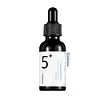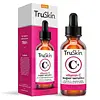What's inside
What's inside
 Key Ingredients
Key Ingredients

 Benefits
Benefits

 Concerns
Concerns

 Ingredients Side-by-side
Ingredients Side-by-side

Vaccinium Vitis-Idaea Fruit Extract
AntioxidantButylene Glycol
HumectantNiacinamide
SmoothingPanthenol
Skin ConditioningTranexamic Acid
AstringentWater
Skin Conditioning1,2-Hexanediol
Skin ConditioningNeopentyl Glycol Dicaprate
EmollientCaprylic/Capric Triglyceride
MaskingSorbitol
HumectantBifida Ferment Lysate
Skin ConditioningChondrus Crispus Extract
Skin ConditioningButyrospermum Parkii Butter
Skin ConditioningSaccharum Officinarum Extract
MoisturisingAlpha-Arbutin
AntioxidantSodium Hyaluronate
HumectantMelia Azadirachta Flower Extract
Skin ConditioningOcimum Sanctum Leaf Extract
Skin ConditioningMelia Azadirachta Leaf Extract
Skin ConditioningCurcuma Longa Root Extract
MaskingCorallina Officinalis Extract
Skin ConditioningTremella Fuciformis Extract
HumectantPentylene Glycol
Skin ConditioningGlycerin
Humectant3-O-Ethyl Ascorbic Acid
Skin ConditioningBisabolol
MaskingTromethamine
BufferingEthylhexylglycerin
Skin ConditioningAdenosine
Skin ConditioningHydrogenated Lecithin
EmulsifyingAllantoin
Skin ConditioningGlutathione
Ceramide NP
Skin ConditioningBeta-Glucan
Skin ConditioningDipotassium Glycyrrhizate
HumectantTocopherol
AntioxidantAscorbic Acid
AntioxidantAscorbyl Glucoside
AntioxidantTocopheryl Acetate
AntioxidantHydroxypropyl Cyclodextrin
MaskingUbiquinone
AntioxidantThioctic Acid
AntioxidantPotassium Hydroxide
BufferingBehenyl Alcohol
EmollientCarbomer
Emulsion StabilisingXanthan Gum
EmulsifyingDisodium EDTA
Vaccinium Vitis-Idaea Fruit Extract, Butylene Glycol, Niacinamide, Panthenol, Tranexamic Acid, Water, 1,2-Hexanediol, Neopentyl Glycol Dicaprate, Caprylic/Capric Triglyceride, Sorbitol, Bifida Ferment Lysate, Chondrus Crispus Extract, Butyrospermum Parkii Butter, Saccharum Officinarum Extract, Alpha-Arbutin, Sodium Hyaluronate, Melia Azadirachta Flower Extract, Ocimum Sanctum Leaf Extract, Melia Azadirachta Leaf Extract, Curcuma Longa Root Extract, Corallina Officinalis Extract, Tremella Fuciformis Extract, Pentylene Glycol, Glycerin, 3-O-Ethyl Ascorbic Acid, Bisabolol, Tromethamine, Ethylhexylglycerin, Adenosine, Hydrogenated Lecithin, Allantoin, Glutathione, Ceramide NP, Beta-Glucan, Dipotassium Glycyrrhizate, Tocopherol, Ascorbic Acid, Ascorbyl Glucoside, Tocopheryl Acetate, Hydroxypropyl Cyclodextrin, Ubiquinone, Thioctic Acid, Potassium Hydroxide, Behenyl Alcohol, Carbomer, Xanthan Gum, Disodium EDTA
Ascorbic Acid
AntioxidantHyaluronic Acid
HumectantRosa Canina Fruit Oil
EmollientDimethyl Sulfone
SolventRetinol
Skin ConditioningSqualane
EmollientNiacinamide
SmoothingArginine
MaskingSalicylic Acid
MaskingCitrus Grandis Peel Oil
MaskingAloe Barbadensis Leaf
MaskingCentella Asiatica Extract
CleansingEquisetum Arvense Extract
AstringentGeranium Maculatum Extract
TonicCarbomer
Emulsion StabilisingPhenoxyethanol
PreservativeEthylhexylglycerin
Skin ConditioningAscorbic Acid, Hyaluronic Acid, Rosa Canina Fruit Oil, Dimethyl Sulfone, Retinol, Squalane, Niacinamide, Arginine, Salicylic Acid, Citrus Grandis Peel Oil, Aloe Barbadensis Leaf, Centella Asiatica Extract, Equisetum Arvense Extract, Geranium Maculatum Extract, Carbomer, Phenoxyethanol, Ethylhexylglycerin
 Reviews
Reviews

Ingredients Explained
These ingredients are found in both products.
Ingredients higher up in an ingredient list are typically present in a larger amount.
Ascorbic Acid is is pure Vitamin C. This form makes up the largest amount of vitamin C found naturally in our skin.
Not only is vitamin C great for your overall health and immune system, it also has plenty of benefits on your skin.
Vitamin C is best used for brightening skin. It improves dark spots, acne scars, and hyperpigmentation. This is because it blocks the process of skin darkening when exposed to UV.
Remember: Vitamin C should not replace sunscreen!
Your skin uses vitamin C to build collagen. Collagen is one key component in having a strong skin barrier and plump skin. Vitamin C also plays a role in regulating collagen, thus making it effective in improving wrinkles and fine lines.
Ascorbic acid shows potent antioxidant activity. As an antioxidant, it helps fight free-radicals. Free-radicals are molecules that may damage your skin cells. These antioxidants also protect skin against UV damage.
The best formulations include Vitamin E and/or ferulic acid. These two ingredients help stabilize and provide a boost in the benefits of ascorbic acid. This is because ascorbic acid becomes unstable when exposed to UV and air. In fact, you can tell your ascorbic acid has oxidized when it turns an orange-yellow color.
Ascorbic acid is generally compatible with other ingredients. However, using ascorbic acid with other active ingredients might cause irritation. Two ingredients: copper ions and benzoyl peroxide, will inactivate ascorbic acid completely.
Read more about other types of Vitamin C:
Foods rich with vitamin C include oranges, strawberries, broccoli, bell peppers, and more. When consuming Vitamin C, your skin receives a portion of the nutrients.
Learn more about Ascorbic AcidCarbomer is a polymer of acrylic acid. Its main role is to create a gel consistency.
A high amount of carbomer can cause pilling or balling up of products. Don't worry, most products contain 1% or less of carbomer.
Ethylhexylglycerin (we can't pronounce this either) is commonly used as a preservative and skin softener. It is derived from glyceryl.
You might see Ethylhexylglycerin often paired with other preservatives such as phenoxyethanol. Ethylhexylglycerin has been found to increase the effectiveness of these other preservatives.
Niacinamide is a multitasking form of vitamin B3 that strengthens the skin barrier, reduces pores and dark spots, regulates oil, and improves signs of aging.
And the best part? It's gentle and well-tolerated by most skin types, including sensitive and reactive skin.
You might have heard of "niacin flush", or the reddening of skin that causes itchiness. Niacinamide has not been found to cause this.
In very rare cases, some individuals may not be able to tolerate niacinamide at all or experience an allergic reaction to it.
If you are experiencing flaking, irritation, and dryness with this ingredient, be sure to double check all your products as this ingredient can be found in all categories of skincare.
When incorporating niacinamide into your routine, look out for concentration amounts. Typically, 5% niacinamide provides benefits such as fading dark spots. However, if you have sensitive skin, it is better to begin with a smaller concentration.
When you apply niacinamide to your skin, your body converts it into nicotinamide adenine dinucleotide (NAD). NAD is an essential coenzyme that is already found in your cells as "fuel" and powers countless biological processes.
In your skin, NAD helps repair cell damage, produce new healthy cells, support collagen production, strengthen the skin barrier, and fight environmental stressors (like UV and pollution).
Our natural NAD levels start to decline with age, leading to slower skin repair, visible aging, and a weaker skin barrier. By providing your skin niacinamide, you're recharging your skin's NAD levels. This leads to stronger, healthier, and younger looking skin.
Another name for vitamin B3 is nicotinamide. This vitamin is water-soluble and our bodies don't store it. We obtain Vitamin B3 from either food or skincare. Meat, fish, wheat, yeast, and leafy greens contain vitamin B3.
The type of niacinamide used in skincare is synthetically created.
Learn more about Niacinamide